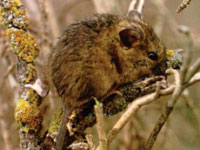It is hard to guess what a Salt marsh harvest mouse weights. But we have the answer:
An adult Salt marsh harvest mouse (Reithrodontomys raviventris) on average weights 10 grams (0.02 lbs).
The Salt marsh harvest mouse is from the family Muridae (genus: Reithrodontomys). They can live for up to 2.58 years. When reaching adult age, they grow up to 7 cm (0′ 3″). On average, Salt marsh harvest mouses can have babies 1 times per year with a litter size of 3.
As a reference: An average human weights in at 62 kg (137 lbs) and reaches an average size of 1.65m (5′ 5″). Humans spend 280 days (40 weeks) in the womb of their mother and reach around 75 years of age.

The salt marsh harvest mouse (Reithrodontomys raviventris), also known as the red-bellied harvest mouse and sometimes called the saltmarsh harvest mouse, is an endangered rodent endemic to the San Francisco Bay Area salt marshes in CA. There are two distinct subspecies, both endangered and listed together on federal and state endangered species lists. The northern subspecies (Reithrodontomys raviventris halicoetes) is lighter in color and inhabits the northern marshes of the bay, and the southern subspecies (Reithrodontomys raviventris raviventris) lives in the East and South Bay marshes. They are both quite similar in appearance to their congener species, the [Western harvest mouse, R. megalotis], to which they are not closely related. Genetic studies of the northern subspecies have revealed that the salt marsh harvest mouse is most closely related to the plains harvest mouse, R. montanus, (), which occurs now in the Midwest]. Its endangered designation is due to its limited range, historic decline in population and continuing threat of habitat loss due to development encroachment at the perimeter of San Francisco Bay.
Animals of the same family as a Salt marsh harvest mouse
We found other animals of the Muridae family:
- Fawn-colored mouse with 4 babies per litter
- Ecuadorian grass mouse with a weight of 39 grams
- Hairy-footed gerbil with a weight of 25 grams
- Large vlei rat with a weight of 192 grams
- Boehm’s gerbil with 4 babies per litter
- Gray tree rat with a weight of 150 grams
- Holochilus chacarius with a weight of 204 grams
- Slender Oldfield mouse with a weight of 77 grams
- Bogotá grass mouse with a weight of 13 grams
- Red rock rat with a weight of 81 grams
Animals with the same weight as a Salt marsh harvest mouse
As a comparison, here are some other animals that weight as much as the Reithrodontomys raviventris:
- Northern bat bringing 10 grams to the scale
- Dark-winged lesser house bat bringing 9 grams to the scale
- Acuminate horseshoe bat bringing 12 grams to the scale
- Taiva shrew tenrec bringing 12 grams to the scale
- Gray long-tongued bat bringing 10 grams to the scale
- Olive-backed pocket mouse bringing 11 grams to the scale
- Tropical big-eared brown bat bringing 11 grams to the scale
- Papillose woolly bat bringing 10 grams to the scale
- Common shrew bringing 9 grams to the scale
- Dark kangaroo mouse bringing 12 grams to the scale
Animals with the same size as a Salt marsh harvest mouse
Not that size really matters, but it makes things comparable. So here are a couple of animals that are as big as Salt marsh harvest mouse:
- Wagner’s gerbil with a size of 8.3 cm (0′ 4″)
- Saharan shrew with a size of 6.3 cm (0′ 3″)
- Smith’s shrew with a size of 8.4 cm (0′ 4″)
- Long-tailed brown-toothed shrew with a size of 6.6 cm (0′ 3″)
- False canyon mouse with a size of 8.4 cm (0′ 4″)
- Somali serotine with a size of 8.4 cm (0′ 4″)
- Hairy-legged vampire bat with a size of 7.9 cm (0′ 4″)
- Eurasian water shrew with a size of 8.1 cm (0′ 4″)
- White-eared pocket mouse with a size of 7.5 cm (0′ 3″)
- Cyclops roundleaf bat with a size of 7.5 cm (0′ 3″)
Animals with the same litter size as a Salt marsh harvest mouse
Here is a list of animals that have the same number of babies per litter (3) as a Salt marsh harvest mouse:
- Crawford’s gray shrew
- Griselda’s striped grass mouse
- Texas mouse
- European wildcat
- Broad-striped dasyure
- White-ankled mouse
- Desert hedgehog
- Salvin’s spiny pocket mouse
- Transandinomys bolivaris
- Long-eared hedgehog
Animals with the same life expectancy as a Salt marsh harvest mouse
Completely different animals, but becoming as old as a Salt marsh harvest mouse:
- Southern bog lemming with an average maximal age of 2.5 years
- Brazilian spiny tree-rat with an average maximal age of 3.08 years
- Chestnut tree mouse with an average maximal age of 2.42 years
- Bower’s white-toothed rat with an average maximal age of 2.83 years
- Red-tailed phascogale with an average maximal age of 3 years
- Parantechinus bilarni with an average maximal age of 3 years
- Northern short-tailed shrew with an average maximal age of 2.75 years
- Bicolored shrew with an average maximal age of 3 years
- Eastern woodrat with an average maximal age of 3 years
- Heermann’s kangaroo rat with an average maximal age of 2.33 years
